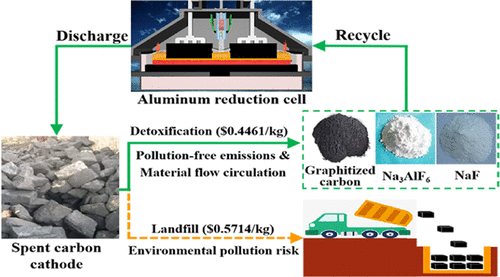当前位置:
X-MOL 学术
›
ACS Sustain. Chem. Eng.
›
论文详情
Our official English website, www.x-mol.net, welcomes your
feedback! (Note: you will need to create a separate account there.)
Detoxification and Recovery of Spent Carbon Cathodes via NaOH–Na2CO3 Binary Molten Salt Roasting–Water Leaching: Toward a Circular Economy for Hazardous Solid Waste from Aluminum Electrolysis
ACS Sustainable Chemistry & Engineering ( IF 7.1 ) Pub Date : 2020-11-04 , DOI: 10.1021/acssuschemeng.0c06067 Zhen Yao 1, 2 , Jin Xiao 3 , Qiuyun Mao 4 , Gang Wang 1 , Lei Tang 1 , Zihan You 1 , Qifan Zhong 3
ACS Sustainable Chemistry & Engineering ( IF 7.1 ) Pub Date : 2020-11-04 , DOI: 10.1021/acssuschemeng.0c06067 Zhen Yao 1, 2 , Jin Xiao 3 , Qiuyun Mao 4 , Gang Wang 1 , Lei Tang 1 , Zihan You 1 , Qifan Zhong 3
Affiliation

|
The conversion of solid waste into secondary resources has become a prerequisite for the sustainable development of the industry. This study focused on the development of the detoxification process for spent carbon cathode (SCC) without environmental pollution risks and the exploration of the recycling direction of recovered carbonaceous materials. First, the mechanism of thermodynamic conversion and decomposition of toxic substances was explored. Parameters of NaOH–Na2CO3 binary molten salt roasting were optimized through an orthogonal design and a single-factor experiment, and gas release behavior during detoxification treatment was investigated. Results showed that most of the fluoride and cyanide were dissociated and decomposed, and the leaching concentration of fluoride and cyanide was as low as 7.58 and 0.12 mg/L after detoxification treatment, respectively. Then, a multistage recovery process of fluorine from fluorine-containing leachate was designed, and the comprehensive utilization of exhaust gas and the recycling of the reaction reagent were realized simultaneously. The possibility of recovering graphitized carbon blending to prepare carbon anodes was discussed in detail, and the catalytic mechanism of main impurity elements on the O2/CO2 reactivity of carbon anodes was investigated via density-functional-based tight binding (DFTB). The results showed that the Boudouard reaction and carbon–O2 reaction were affected because of the presence of Ca or Na, and the recovered graphitized carbon with a low blending ratio was more suitable for the preparation of carbon anodes. Finally, an economic benefit analysis was conducted to evaluate the industrial application potential of the proposed detoxification treatment. Compared with landfills, the proposed process reduced the disposal cost while eliminating environmental pollution risks and realized the on-site recovery and reuse of valuable components, showing considerable environmental and economic benefits.
中文翻译:

NaOH-Na 2 CO 3二元熔盐焙烧-水浸出的废碳阴极的解毒和回收:循环电解铝产生的危险固体废物经济
将固体废物转化为二次资源已成为该行业可持续发展的先决条件。这项研究的重点是开发无环境污染风险的废碳阴极(SCC)的解毒工艺,并探索回收的碳质材料的再循环方向。首先,探讨了热力学转化和有毒物质分解的机理。NaOH–Na 2 CO 3的参数通过正交设计和单因素实验对二元熔融盐焙烧进行了优化,并研究了排毒过程中的气体释放行为。结果表明,解毒后大部分氟化物和氰化物分解分解,氟和氰化物的浸出浓度分别低至7.58和0.12 mg / L。然后,设计了从含氟浸出液中回收氟的多阶段方法,同时实现了废气的综合利用和反应试剂的循环利用。详细讨论了回收石墨化碳共混物制备碳阳极的可能性,以及主要杂质元素对O 2 / CO 2的催化机理。通过基于密度功能的紧密结合(DFTB)研究了碳阳极的反应性。结果表明,由于Ca或Na的存在,影响了Boudouard反应和carbon-O 2反应,回收的低配比石墨化碳更适合制备碳阳极。最后,进行了经济效益分析,以评估所提出的排毒治疗的工业应用潜力。与垃圾填埋场相比,拟议的流程降低了处置成本,同时消除了环境污染风险,并实现了有价值成分的现场回收和再利用,显示出可观的环境和经济效益。
更新日期:2020-11-16
中文翻译:

NaOH-Na 2 CO 3二元熔盐焙烧-水浸出的废碳阴极的解毒和回收:循环电解铝产生的危险固体废物经济
将固体废物转化为二次资源已成为该行业可持续发展的先决条件。这项研究的重点是开发无环境污染风险的废碳阴极(SCC)的解毒工艺,并探索回收的碳质材料的再循环方向。首先,探讨了热力学转化和有毒物质分解的机理。NaOH–Na 2 CO 3的参数通过正交设计和单因素实验对二元熔融盐焙烧进行了优化,并研究了排毒过程中的气体释放行为。结果表明,解毒后大部分氟化物和氰化物分解分解,氟和氰化物的浸出浓度分别低至7.58和0.12 mg / L。然后,设计了从含氟浸出液中回收氟的多阶段方法,同时实现了废气的综合利用和反应试剂的循环利用。详细讨论了回收石墨化碳共混物制备碳阳极的可能性,以及主要杂质元素对O 2 / CO 2的催化机理。通过基于密度功能的紧密结合(DFTB)研究了碳阳极的反应性。结果表明,由于Ca或Na的存在,影响了Boudouard反应和carbon-O 2反应,回收的低配比石墨化碳更适合制备碳阳极。最后,进行了经济效益分析,以评估所提出的排毒治疗的工业应用潜力。与垃圾填埋场相比,拟议的流程降低了处置成本,同时消除了环境污染风险,并实现了有价值成分的现场回收和再利用,显示出可观的环境和经济效益。











































 京公网安备 11010802027423号
京公网安备 11010802027423号